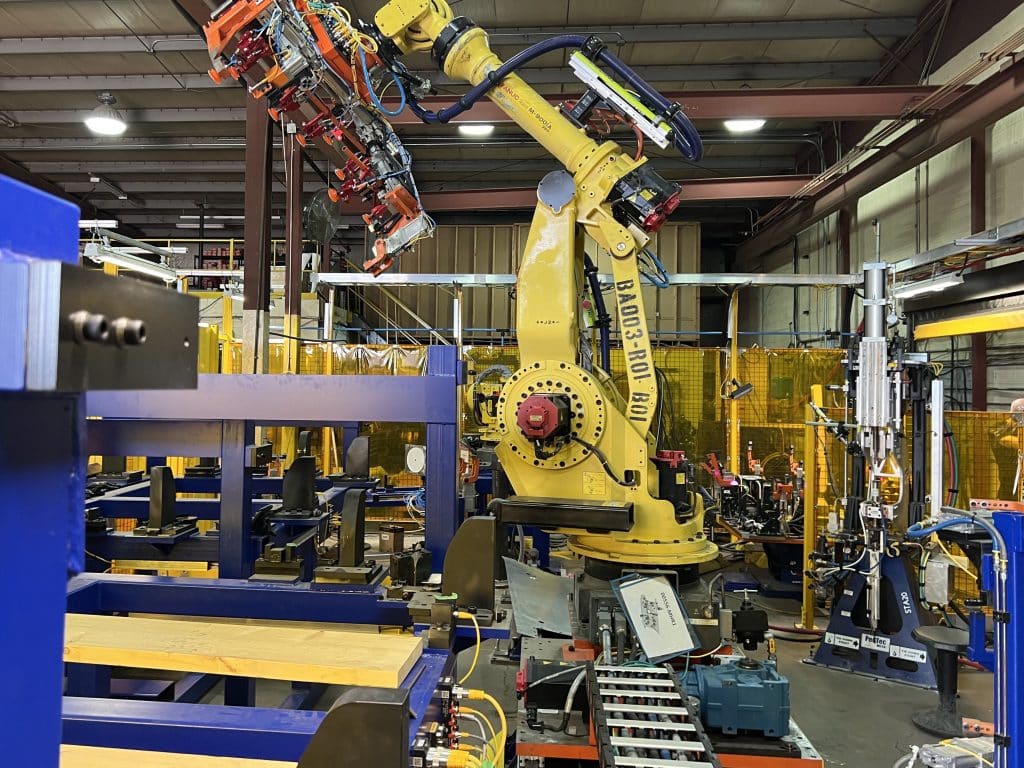What is a 7th Axis? Why do you need it for a mounted robot?
When automating with a robot, the number of axes or degrees of freedom on the robotic arm determine how it can move and impact how much space it will require. Typically, up to 6 axes can be accommodated on a robotic arm, which is bolted to the floor, ceiling or mounted on a base. Adding a 7th axis or a track allows the robot to also move linearly – either horizontally or vertically. Track-mounted robots offer multiple benefits. including adding extra reach, minimizing costs, saving space, increasing flexibility and possibly saving the cost of an extra robot.
Adding extra reach to a robot arm with track mounting
A linear track can give a robot extra reach that would typically require a longer arm and more expensive robot. This extra reach is particularly useful for pick-and-place applications, machine tending, and even welding, painting, and other tasks. By optimizing reach using a track, the robot will be less bulky and take up less space than if it had a longer arm.
Maximizing the use of each robot
With a track system, one robot can move down the production line or to another location to perform additional operations. Using the same robot at multiple stations reduces the number of robotic arms needed and speeds up the payback of the robot doing this double duty. Moving one robot along a track is often significantly more efficient than using multiple units to perform each task. A track-mounted robot can also be designed to move at high speed for high productivity and throughput, and shorter cycle times. By using fewer units, minimizing floor space, and increasing efficiency, automation solutions designed with robots on tracks can significantly reduce costs.
Saving space with inverted rails
Inverted rails or gantry systems are an excellent example of the benefits of redesigning a work cell to take full advantage of robotic automation. Inverted rails can be used to suspend robotic arms so the base is above the end effector that performs the work. With the robotic arms held up by the rail mounting system, an inverted design can save significant floor space. Overhead rails are particularly useful for loading/unloading and palletizing operations. Inverted robotic arms can stack items higher more efficiently than a floor-mounted design. An inverted robot can also reach high places that would present a safety hazard for humans to access.
Increasing versatility and flexibility of the robotic solution design
Since a track system takes up less space and can reduce the reach required on the robotic arm itself, there will be fewer design constraints on the overall system. Also, tracks can be set up with a variety of mounting orientations, allowing even greater flexibility to optimize space and efficiency. For example, angle mounting can be used for precise positioning, and to accommodate custom requirements.
Integrating track-mounted robots into an automation plan
The optimal way to design a track-mounted system will depend on the operations being performed, floor space available, safety concerns, and many additional factors. Independent manufacturers specialize in linear axes, providing modular components that can be combined with automation solutions. Many of the major robot manufacturers have rail-mounted robots.
As for negatives, it takes more upfront engineering work to calculate the size, payloads and constraings. But other then that, 7th axis is always a positive
At Ethos we are experts at automated welding automation for automotive Tier 1 and other industries. If you would like to learn more about implementing track-mounted robots, contact us at



